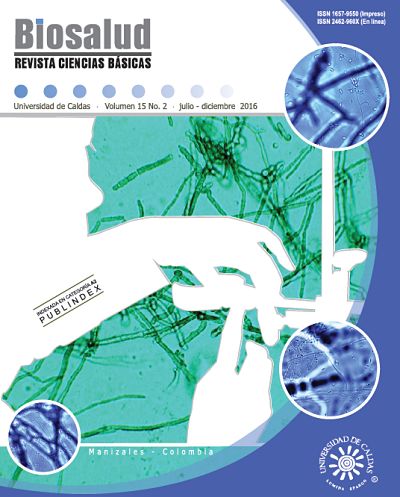Autores/as
Resumen
Introducción: La distrofia miotónica es una enfermedad poco frecuente de origen genético. Se produce por aumento de repeticiones de la tripleta CTG en el gen DMPK (locus 19q13.32), o por aumento de repeticiones de CCTG en el gen ZNF9 (locus3q21.3). Su fenotipo es variable y sus principales características son la debilidad muscular progresiva y la miotonía. El objetivo de esta publicación es reportar un caso colombiano de distrofia miotónica tipo 1 con diagnóstico molecular y contribuir a la construcción de datos epidemiológicos locales sobre esta patología. Además, aportar información a médicos generales, pediatras, internistas, fisiatras, neurólogos, y en general al personal de salud que puede tener contacto con pacientes con debilidad muscular progresiva, escenario en el cual la distrofia miotónica es una posibilidad diagnóstica a considerar. Descripción del caso: Hombre de 37 años, con historia de pobre succión neonatal, retraso en los hitos del desarrollo, discapacidad intelectual y, en la adolescencia, aparición de debilidad progresiva generalizada, miotonía y disfagia. El Southernblot y PCR del gen DMPK mostraron un alelo expandido en un rango entre 1100 a 1700 repeticiones del triplete CGT y un alelo normal, confirmando el diagnóstico de distrofia miotónicatipo 1. Conclusión: El paciente aquí reportado presentó fenotipo sugestivo de DM1; el diagnóstico fue confirmado con la prueba molecular. Con el resultado fue posible realizar una consejería genética adecuada y brindar información sobre la enfermedad.
Citas
2. Cassidy S, Allanson J. Management of Genetic Syndromes. 2nd Edition. New Jersey, John Wiley & Sons, Inc; 2005.
3. Höweler CJ, Busch HF, Geraedts JP, Niermeijer MF, Staal A. Anticipation in myotonic dystrophy: fact or fiction? Brain 1989; 112 (Pt 3):779–97.
4. Prior TW. Technical standards and guidelines for myotonic dystrophy type 1 testing. Genet Med 2009; 19; 11(7):552–5.
5. Savić Pavićević D, Miladinović J, Brkušanin M, Šviković S, Djurica S, Brajušković G, et al. Molecular Genetics and Genetic Testing in Myotonic Dystrophy Type 1. Biomed Res Int 2013; 2013:1–13.
6. Mahadevan M, Tsilfidis C, Sabourin L, Shutler G, Amemiya C, Jansen G, et al. Myotonic dystrophy mutation: an unstable CTG repeat in the 3’ untranslated region of the gene. Science 1992; 255(5049):1253–5.
7. GeneReviews® [Internet]. Disponible en: https://www.ncbi.nlm.nih.gov/books/NBK1165. Consultado Mayo de 2016
8. Harley HG, Brook JD, Rundle SA, Crow S, Reardon W, Buckler AJ, et al. Expansion of an unstable DNA region and phenotypic variation in myotonic dystrophy. Nature 1992; 355(6360):545–6.
9. Online Mendelian Inheritance in Man, OMIM® [Internet]. Disponible en: http://omim.org/. Consultado Mayo de 2016
10. Botta A, Rinaldi F, Catalli C, Vergani L, Bonifazi E, Romeo V, et al. The CTG repeat expansion size correlates with the splicing defects observed in muscles from myotonic dystrophy type 1 patients. J Med Genet 2008; 45(10):639–46.
11. Usdin K. The biological effects of simple tandem repeats: Lessons from the repeat expansion diseases. Genome Res 2008; 18(7):1011–9.
12. Klesert TR, Cho DH, Clark JI, Maylie J, Adelman J, Snider L, et al. Mice deficient in Six5 develop cataracts: implications for myotonic dystrophy. Nat Genet 2000; 25(1):105–9.
13. Frisch R, Singleton KR, Moses PA, González IL, Carango P, Marks HG, et al. Effect of triplet repeat expansion on chromatin structure and expression of DMPK and neighboring genes, SIX5 and DMWD, in myotonic dystrophy. Mol Genet Metab 2001; 74(1-2):281–91.
14. Chahine M, George AL. Myotonic dystrophy kinase modulates skeletal muscle but not cardiac voltagegated sodium channels. FEBS Lett 1997; 412(3):621–4.
15. Tishkoff DX, Filosi N, Gaida GM, Kolodner RD. A novel mutation avoidance mechanism dependent on S. cerevisiae RAD27 is distinct from DNA mismatch repair. Cell 1997; 88(2):253–63.
16. Mankodi A, Urbinati CR, Yuan QP, Moxley RT, Sansone V, Krym M, et al. Muscleblind localizes to nuclear foci of aberrant RNA in myotonic dystrophy types 1 and 2. Hum Mol Genet 2001; 10(19):2165–70.
17. Miller JW, Urbinati CR, Teng-Umnuay P, Stenberg MG, Byrne BJ, Thornton CA, et al. Recruitment of human muscleblind proteins to (CUG)(n) expansions associated with myotonic dystrophy. EMBO J 2000; 19(17):4439–48.
18. Kanadia RN, Johnstone KA, Mankodi A, Lungu C, Thornton CA, Esson D, et al. A muscleblind knockout model for myotonic dystrophy. Science 2003; 302(5652):1978–80.
19. Llamusi B, Artero R. Molecular Effects of the CTG Repeats in Mutant Dystrophia Myotonica Protein Kinase Gene. Curr Genomics 2008; 9(8):509–16.
20. Timchenko NA, Cai ZJ, Welm AL, Reddy S, Ashizawa T, Timchenko LT. RNA CUG repeats sequester CUGBP1 and alter protein levels and activity of CUGBP1. J Biol Chem 2001; 276(11):7820–6.
21. Ho TH, Bundman D, Armstrong DL, Cooper TA. Transgenic mice expressing CUG-BP1 reproduce splicing mis-regulation observed in myotonic dystrophy. Hum Mol Genet 2005; 14(11):1539–47.
22. Harley HG, Rundle SA, MacMillan JC, Myring J, Brook JD, Crow S, et al. Size of the unstable CTG repeat sequence in relation to phenotype and parental transmission in myotonic dystrophy. Am J Hum Genet 1993; 52(6):1164–74.
23. Hunter A, Tsilfidis C, Mettler G, Jacob P, Mahadevan M, Surh L, et al. The correlation of age of onset with CTG trinucleotide repeat amplification in myotonic dystrophy. J Med Genet 1992; 29(11):774–9.
24. Redman JB, Fenwick RG, Fu YH, Pizzuti A, Caskey CT. Relationship between parental trinucleotide GCT repeat length and severity of myotonic dystrophy in offspring. JAMA 1993; 269(15):1960–5.

 pdf
pdf
 FLIP
FLIP


















